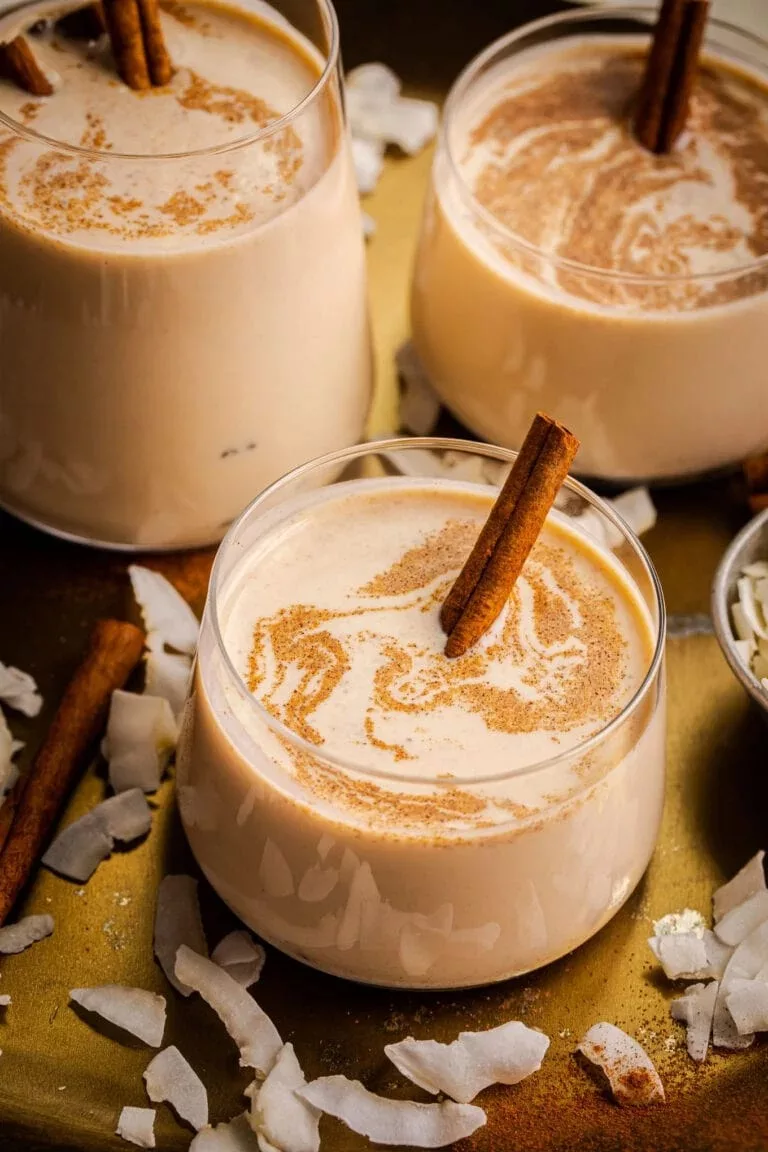Nothing compares to coquito, an alcoholic beverage with a coconut base that is typically consumed during the holidays. Coquito, also referred to as Puerto Rican eggnog, is made mostly of coconut-based components, rum, and warm spices like nutmeg and cinnamon. This drink is incredibly tasty, creamy, and easy to make.
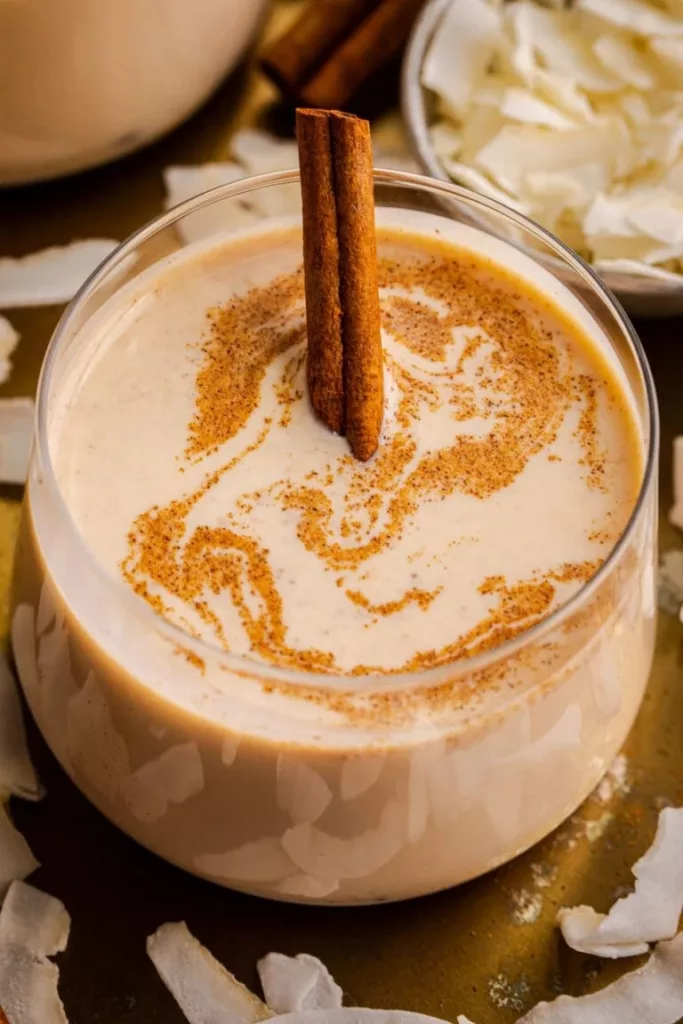
December, everyone! It’s finally the last month of the year, hehe. Is your Yuletide tree decorated yet? Did you find any good deals on Black Friday? Finally, could you kindly confirm that you haven’t had any leftovers from Thanksgiving yet? 👀 In any case, there are a lot of reasons why I adore December. We’re starting off with the coquito, which is one of my favorite holiday-inspired drinks.
Coquito, Coquito, Coquito!
While I like to drink this all year round, I really like to make large amounts during the holidays. Rum, spices, and coconut are the main components in the creamy coconut rum drink known as coquito. Because of its Latin ancestry, it’s simple to prepare and known as Puerto Rican eggnog. Because my family is from St. Thomas, USVI, which is near to Puerto Rico, I’ve always been familiar with coquito. It’s a popular seasonal beverage that’s perfect for celebrating culture.
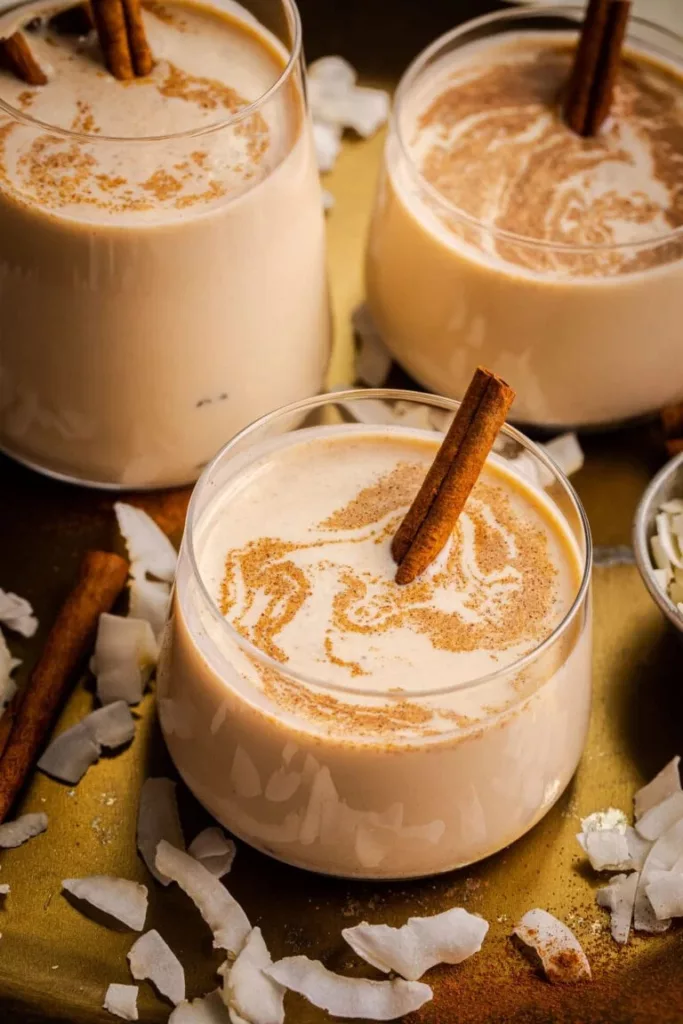
A Lil’ History On Coquito
Coquito, which means “little coconut” in Spanish, is a Puerto Rican native. This is a typical Christmas drink that is offered throughout the holidays. Many households customize this beverage using different ingredients or preparation techniques. To each their own, people may choose to use fresh coconut meat or milk, spiced tea, or something else entirely.
It’s common to compare coquito to eggnog, and it does resemble it somewhat. There are a few variations, though.and it’s lot better, in my opinion! I like coquito’s all-coconut flavor with warm spices and Puerto Rican rum. To be honest, I brew a batch around this time of year and deliver bottles to my team as small tokens of appreciation.
⇐ I’ve got you covered with lots of helpful photographs, a full video instruction, and tips and techniques for your coquito inspiration! 😊
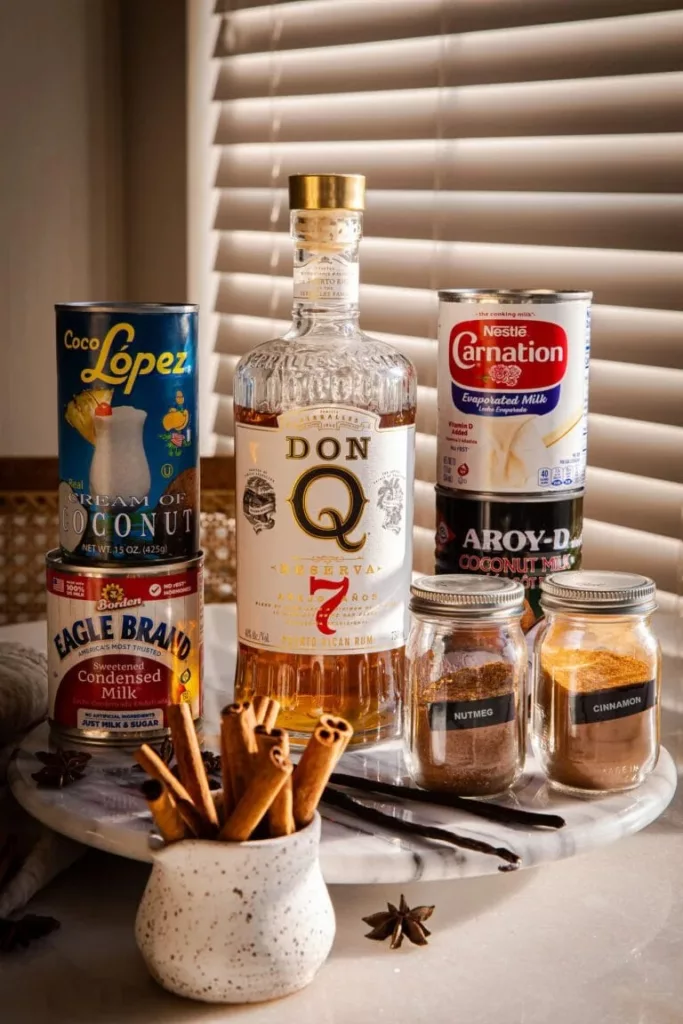
Ingredients Needed For This Recipe
- Coconut cream: This item should not be confused with coconut cream, which is a separate product. I use Coco Lopez for coconut cream.
- Sweetened condensed milk: A delicious way to add sweetness to the coquito.
- Full-fat coconut milk is required for richness.
- Evaporated milk: Contributes creaminess and helps to balance the tastes of the milk.
- Rum: Choose your preferred variety, either white or black; we’ll talk more about this later.
- Vanilla extract: A pleasant flavoring that adds a subtle depth of fragrance.
- Nutmeg and cinnamon: These toasty spices work as a kind of drink flavoring, hehe! To be honest, the earthy tones of nutmeg and cinnamon add a hearty, comforting touch.
- Salt: Totally optional; just a little for harmony.
- Cinnamon sticks: I use these for garnishing and bottling the coquito.
⇐ Look, all you need are a items (most of which you probably already have!) 🙌🏾
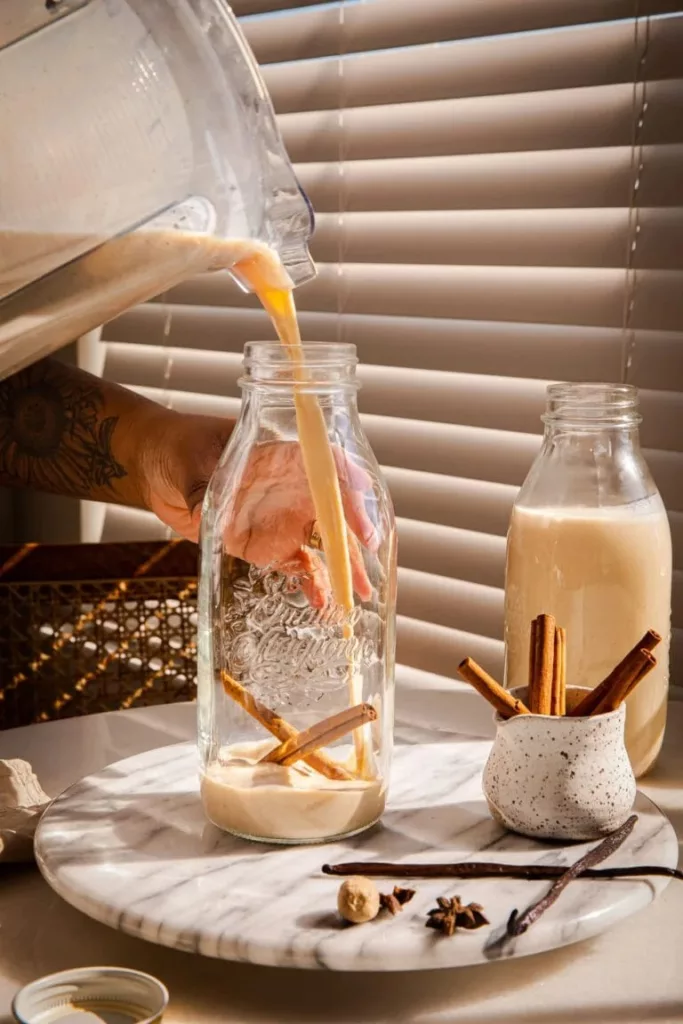
How To Make Coquito (sooo easy!)
- Blend: Place all the ingredients into the body of a large, high-speed blender. Blend the ingredients until all pieces are gone, leaving just a smooth texture.
- Fill your bottle(s) with the cinnamon sticks to make a bottle coquito. Next, slowly fill them with the coquito, allowing room for shaking. To completely mix in all the components, close the bottles and shake well.
- Rest & allow to heal: Put in the fridge to cool and solidify.
- Provide: Give it a good shake, then serve the coquito in individual glasses (with or without ice) and decorate with a cinnamon stick or, if preferred, a dusting of nutmeg or cinnamon. Drink and relish, friends! ♥
Customizing Your Coquito
You guys, this recipe creates an insanely good batch of coquito. But listen, don’t hesitate to change anything to your preference. Try yours and adjust the amount of rum to your personal taste. Add extra sweetened condensed milk, sugar, etc. if you’d like it sweeter. Experiment until you find the perfect fit.
Let It Chill, Homie
When everything is said and done, you’ll want to just let everything out. Yes, I am aware. But give the coquito at least four hours to chill—that’s the least amount of time I suggest. It is preferable to let the coquito a full day or 24 hours to relax. As the rum’s strength lessens and its taste deepens, the curing process will give the coquito a more complex flavor profile. Apart from that, the coquito will get a rich texture and thicken as it cools.

Tips + Tricks, Notes, & FAQs About This Recipe
You could have further inquiries concerning this recipe for coquito. As with previous recipes, my advice is to follow the directions exactly as they are listed on the recipe card that is just below. However, the following additional information may be useful to you:
- The best rum for coquito: Most basic coquito recipes call for white rum. But rum that is dark or aged, spiced, or flavored with coconut will add a little razzle dazzle and chef’s kiss taste! * Look for Puerto Rican rum such as Don Q, Bacardí, Ron del Barrilito, Palo Viejo, etc. for real coquito.Unbelievably, Bacardí—which is frequently used in this recipe—is not Puerto Rican.
- Bottle types: Approximately 60 ounces (1.75 liters) of coquito may be made with this recipe. Glass carafes, mason jars, weck jars, or any other glass container you have with an airtight top are the ones I like to use. Images of these glass bottles are provided for context.
- Texture of coquito: This drink stays quite smooth in my experience, although occasionally you may see some chunky parts from the hardened coconut oil. Before serving, it’s simple to either reject or reblend the mixture.
- Coquito that is vegan or dairy-free: These may be easily substituted with sweetened condensed coconut milk (11.25 ounce can) and evaporated coconut milk (12.2 ounce can). If not, use one and a half cups of your preferred alternative milk (additional coconut milk for added taste, almond milk, or oat milk) in place of the evaporated milk. Use two cups of alternative milk and three to four teaspoons of sugar, according to taste, if you don’t have dairy-free sweetened condensed milk.
- Virgin (non-alcoholic) coquito: You may easily switch out the rum alcohol with a non-alcoholic rum substitute at a 1:1 ratio if you’d like. If not, completely eliminate the rum from the recipe. If you want your virgin coquito to be dairy-free as well, use the preceding instructions to make the required modifications. The ideal choice for serving little children or people who don’t drink!
How Long Does Coquito Last?
This coquito lasts a long time because it isn’t made with eggs. Coquito will last for two weeks if stored in the refrigerator and is always sealed with an airtight lid. Although you might be able to finish it earlier, I do advise eating it within that window of time. Before serving, give the coquito a good shake!

Other bomb recipes you might enjoy:
- Cold Brew Coffee
- Triple Berry Smoothie
- Carrot Ginger Smoothie
- Carrot Ginger Smoothie
- Pineapple Mango Smoothie
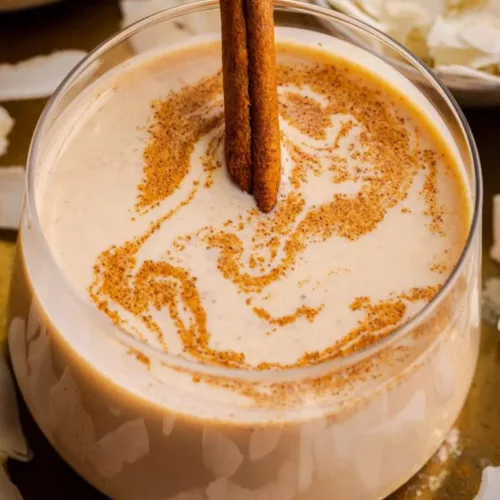
Coquito (Puerto Rican Coconut Rum Cocktail)
Ingredients
- 1 15-ounce can cream of coconut
- 1 14-ounce can sweetened condensed milk
- 1 14-ounce can full-fat coconut milk
- 1 12-ounce can evaporated milk
- 1 ½ cups good-quality rum see notes
- 2 teaspoons vanilla extract
- 1 ½ teaspoons ground cinnamon
- ½ teaspoon ground nutmeg
- pinch of salt optional
- 2 –4 cinnamon sticks optional for bottling
For serving & garnishing coquito- optional:
- cinnamon sticks and/or ground cinnamon/nutmeg
Instructions
- Combine: Place the coconut cream, sweetened condensed milk, coconut milk, evaporated milk, rum, vanilla extract, cinnamon, nutmeg, and salt (if used) in the body of a large, high-speed blender.
- Blend the contents until it’s thoroughly incorporated and absolutely smooth. In order to make sure the coconut cream has completely dissolved and there are no pieces remaining, I prefer to double-check the mixture with a whisk or rubber spatula.
- Coquito in a bottle: This recipe yields approximately 60 ounces of coquito. Glass carafes, mason jars, weck jars, or any other glass container you have with an airtight top are the ones I like to use. If using cinnamon sticks, add them to your glass vessel(s) in the following manner: split the sticks between two bottles or put all of the sticks in one bottle. Next, slowly transfer the coquito into the vessel or vessels, being sure to leave an inch of headroom for shaking. To properly integrate all the ingredients, shake well after closing the bottles and serving the coquito.
- Chill and allow to cure: Place your coquito in the fridge. Let the coquito rest for a minimum of four hours. It is preferable to let the coquito a full day or 24 hours to relax. As the rum’s strength lessens and its taste deepens, the curing process will give the coquito a more complex flavor profile.
- Serving Tip: Before serving, give the coquito a good shake! If preferred, top the coquito (served with or without ice) with a sprinkle of nutmeg or cinnamon and/or a cinnamon stick garnish. I salute you all!
- Coquito storage: This coquito keeps for a long time because it isn’t made with eggs. Coquito will last for two weeks if stored in the refrigerator and is always sealed with an airtight lid. Although you might be able to finish it earlier, I do advise eating it within that window of time.
Notes
- Coconut milk: For this recipe, use full-fat, premium coconut milk! There should be a thick coating of coconut cream directly on top of the can of coconut milk. Your coquito’s thickness is influenced by its creaminess; without it, its texture wouldn’t be as rich.
- Use your favorite rum, white or black, according to the notes. Basic recipes for coquito usually call for white rum. But rum that is dark or aged, spiced, or flavored with coconut will add a little razzle dazzle and chef’s kiss taste! Choose *Puerto Rican* rum such as Don Q, Bacardí, Ron del Barrilito, Palo Viejo, etc. for real coquito.
- Coquito that is vegan or dairy-free: These may be easily substituted with sweetened condensed coconut milk (11.25 ounce can) and evaporated coconut milk (12.2 ounce can). If not, use one and a half cups of your preferred alternative milk (additional coconut milk for added taste, almond milk, or oat milk) in place of the evaporated milk. Use two cups of alternative milk and three to four teaspoons of sugar, according to taste, if you don’t have dairy-free sweetened condensed milk.
- Virgin (non-alcoholic) coquito: You may easily switch out the rum alcohol with a non-alcoholic rum substitute at a 1:1 ratio if you’d like. If not, completely eliminate the rum from the recipe. If you want your virgin coquito to be dairy-free as well, use the preceding instructions to make the required modifications. The ideal choice for serving little children or people who don’t drink! Note: You only need to chill virgin coquito in the refrigerator for a short while—as said in step #4.
For further advice and tactics, please read the blog article in its full.
